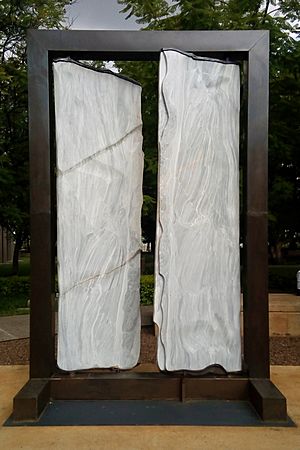Ángela Gurría facts for kids
Quick facts for kids
Ángela Gurría Davó
|
|
|---|---|

Gurría in 2013
|
|
| Born | 24 March 1929 Mexico City, Mexico
|
| Died | 17 February 2023 (aged 93) Mexico City, Mexico
|
| Known for | Sculpture |
Ángela Gurría Davó (born March 24, 1929 – died February 17, 2023) was a very important Mexican sculptor. She made amazing large sculptures that you can see in public places. In 1974, she became the first woman to join the Academia de Artes (Academy of Arts) in Mexico. One of her most famous works is Señal, a huge sculpture created for the 1968 Summer Olympics. Ángela Gurría lived and worked in Mexico City for most of her life.
Biography
Ángela Gurría was born in Mexico City. Her family was very traditional. Her father was strict, and it was hard for women to have a career, especially in art, back in the 1940s. Even as a child, Ángela loved watching stonemasons work near her home. She knew she wanted to be an artist, specifically a sculptor.
She first went to the Universidad Nacional Autónoma de México to study writing. But after taking a modern art class, she decided to go back to visual art.
Even though many people thought women shouldn't be sculptors, she started her art journey. In the early 1960s, she traveled to Europe to study art. She visited England, Italy, and France. Later, she also spent time in Greece and New York.
Ángela Gurría passed away on February 17, 2023, when she was 93 years old.
Career
Ángela Gurría was one of Mexico's most active sculptors. She became well-known in the 1960s for her large public sculptures across Mexico.
In 1952, she started learning from sculptor Germán Cueto for six years. She also worked with other artists to learn about making sculptures. It was very difficult for women to be taken seriously as sculptors then. So, Ángela sometimes used male names like Alberto Urría or Angel Urría for her works. She even used a male name when she submitted her first big sculpture, La familia obrera, in 1965. When the organizers found out she was a woman, they were very surprised!
In 1967, she created a tall, decorative door for the main entrance of the bank note factory of the Banco de México. This work won her first prize at an important art show called the III Bienal Mexicana de Escultura.
Her most famous work is Señal (which means "Signal"). She made it for the cultural part of the 1968 Summer Olympics. This sculpture is eighteen meters (about 59 feet) tall! It looks like two horn-shaped figures, one black and one white. This design represented the many African nations that were taking part in the Olympics for the first time. After the Olympics, the sculpture was moved to a different spot in Mexico City.
In 1975, she joined a group of artists to create a huge sculpture in Tabasco. She worked with other famous sculptors like Mathias Goeritz and Sebastián.
Some of her other important sculptures include Contoy (1974), Monumento México (1974), and the beautiful sculpted glass works at the Basilica of Guadalupe in Monterrey.
Besides making huge sculptures, Ángela Gurría also had many exhibitions of her smaller works. Her first solo show was in 1959. She also had big shows at the Museo de Arte Moderno in 1974 and 2004.
She also taught sculpture at universities. In 1969, she worked on industrial design, creating carpet designs. She wanted to help create jobs for weavers in Mexico.
Ángela Gurría received many awards and honors for her work. She won prizes in 1960, 1967, 1973, and a gold medal in Italy in 1980. She became a member of the Salón de la Plástica Mexicana. In 1974, she made history by becoming the first woman to be accepted into the Academia de Artes. In 2008 and 2010, she was honored at special events for her amazing contributions to art.
Artistry
Ángela Gurría became famous in the late 20th century. She was one of the first artists to create abstract sculptures in Mexico. Abstract art means the art doesn't show things exactly as they look in real life.
Her early works were more realistic, sometimes even religious. But over time, her art became more abstract. However, she often still used shapes inspired by nature, like people, animals, plants, and landscapes. She once said that sculpture is an idea that uses shapes to grow and space to show its geometry. Her art often explored ideas like time, myths, life and death, Mexican folk art, and ancient Pre-Columbian beliefs. She also made sure her sculptures fit well with their surroundings, whether it was a building or nature.
She used many different materials for her sculptures. These included bronze, steel, marble, sandstone, ceramics, iron, volcanic stone, and obsidian. She is best known for her very large sculptures, some reaching up to 100 meters (over 300 feet) tall! But she also made smaller pieces, some as tiny as thirty centimeters (about one foot) high.
Her later works often didn't have her signature. Ángela Gurría believed that her art itself was her signature.
See also
 In Spanish: Ángela Gurría para niños
In Spanish: Ángela Gurría para niños


